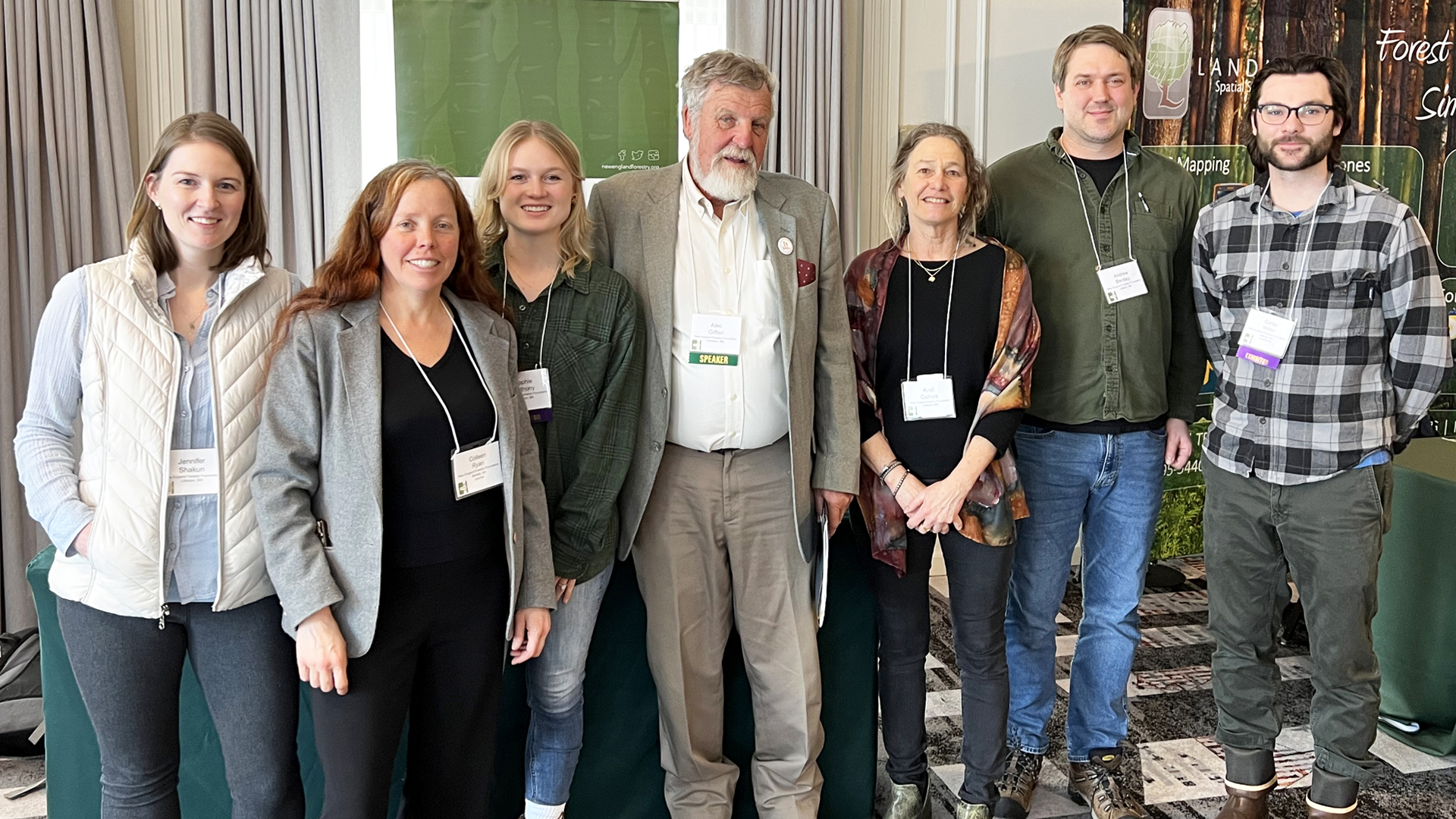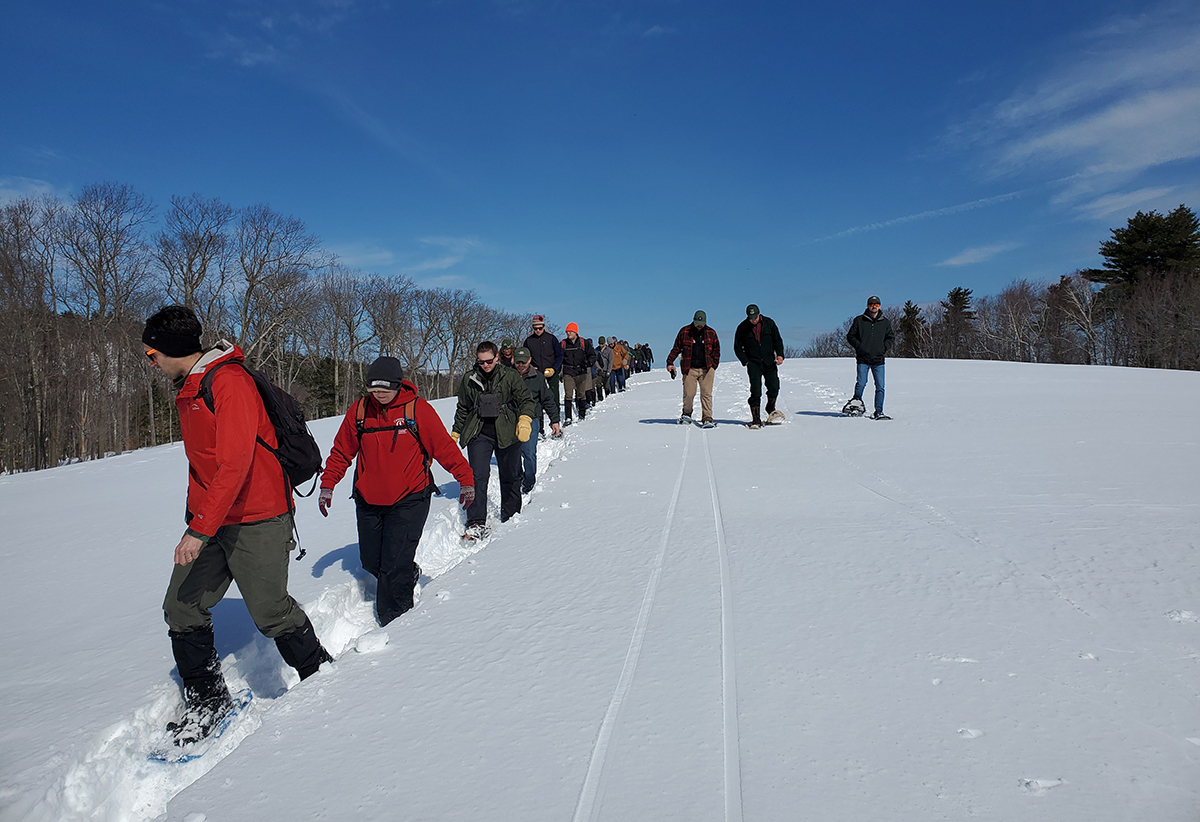Announcing Summer Harvest at Prouty Woods Community Forest
NEFF is conducting a climate-smart timber harvest at Prouty Woods Community…

In honor of the spring 2024 conference season starting to heat up, read about our dedicated staff having a very different—by which we mean cold—sort of experience last spring. Be sure to stay tuned for NEFF’s 2024 conference schedule, as well.
In March 2023, seven intrepid staffers braved a blizzard to represent New England Forestry Foundation (NEFF) at the New England meeting of the Society of American Foresters, held over three days in Nashua, New Hampshire.
The Society of American Foresters is the leading organization for the forestry profession, and each year, it hosts national and regional meetings that allow foresters and people in related professions to keep up with current developments in the field and share best practices and emerging knowledge. With a wide array of attendees, from boots-on-the-ground foresters to students and researchers, these events offer NEFF a way to stay engaged in current discussions about forest management and to share our groundbreaking work with the forestry community.
NEFF Senior Forest Science and Policy Fellow Alec Giffen and I both presented on NEFF’s recent work, while NEFF Stewardship Associate Corey Wrinn and NEFF Conservation Project Manager Sophie Anthony fielded questions and handed out information at the NEFF booth. NEFF Deputy Director and Climate Fellow Andi Colnes, Conservation Easement Director Andrew Bentley, and Bioeconomy Initiative Director Jen Shakun were there to cheer us on, make connections, and learn from various sessions.

NEFF at NESAF: Bioeconomy Initiative Director Jen Shakun, Forest Scientist Colleen Ryan, Conservation Project Manager Sophie Anthony, Senior Forest Science and Policy Fellow Alec Giffen, Deputy Director and Climate Fellow Andi Colnes, Conservation Easement Director Andrew Bentley, Stewardship Associate Corey Wrinn
Alec’s presentation covered the need to manage forests for carbon and the full range of other values, with a focus on the role of harvested wood products in fighting climate change. I gave a flash talk on a paper we published in the fall that estimated the potential for storing additional carbon in the Acadian Forest of New England by spreading Exemplary Forestry. Despite timing challenges—my presentation was in an 8 a.m. session and Alec’s was at 5 p.m. on the last day of the meeting—both talks were well-received and generated many thoughtful questions.
Alec’s talk, in particular, generated a lot of interest and a lively discussion about how to ensure carbon benefits from forestry are real and lasting.
Overall, I was inspired by the number of bright, creative people who came to the meeting to share their ideas and experiences despite the challenging weather. This reflects the true commitment many forestry professionals have to the forest and the people who depend on it—or, in other words, all of us.
The meeting’s highlights included discussions about the social contract that allows us to do our work managing forests, and how we can better communicate the value of good forestry to the interested public. A throughline in the meeting was the concern that we as foresters are not doing a good enough job explaining what we do, especially how good forest management is important for values other than timber production. This came up in sessions on old-growth management and the role of forests in providing pollinator habitat, as well as in Alec’s presentation.
The theme of improving how we communicate about forestry continued during a field trip the Society for the Protection of New Hampshire Forests led on one of their forests in the southern part of the state.
This tour took place following a surprise March blizzard that left two feet of snow on the ground, but the participants took it in stride, donning snowshoes and, in one case, skis, to explore the 1,492-acre site.

NESAF 2023 field trip participants included foresters from the public and private sectors, wildlife biologists, land stewards, and even a pollinator biologist. Photo by Colleen Ryan.
Like NEFF, the Forest Society approaches management from a landscape perspective, and considers what important features might be lacking in the surrounding area that could be provided by a given parcel. In a landscape that’s highly fragmented, the best strategy might be to leave large forest blocks unharvested. However, the forest we toured was adjacent to some other conservation land that’s managed as a forest reserve, which means that blocks of mature forest will likely persist on the landscape into the future.
What was lacking in this area was early successional habitat: open fields, shrubs, and very young forest. As a result, the Forest Society decided to manage a portion of the land in open meadow and another portion in shrubs to benefit wildlife species that depend on early successional habitat, including songbirds and pollinators. In the surrounding managed forest, they are enhancing late successional features by creating snags—standing dead trees that provide habitat for many wildlife species, including bats—and large downed logs, and by leaving some large trees, especially those with wildlife features like cavities or canopy structure favored by nesting raptors.
The tour group, which included working foresters, wildlife biologists and stewardship managers, discussed the challenges of balancing different objectives, such as improving habitat for different types of wildlife, managing invasive species, and providing recreational access to local people. Though many of these objectives are complementary, they can also compete with each other. On this site, the removal of invasive shrubs actually reduced wildlife food sources in the short term, but with the goal of creating a healthier ecosystem in the long run.
A great benefit of events like the NESAF field trip is the chance to hear the diverse perspectives of different natural resource professionals who might not interact in their typical day-to-day work. Attendees shared ideas about the challenges and opportunities the site presented and compared how they would approach managing each stand. Everyone learned something from this thoughtful discussion, and we all enjoyed a beautiful day in the sparkling fresh snow.